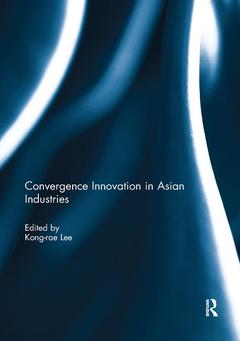Convergence Innovation in Asian Industries
Coordonnateur : Lee Kong-Rae

This book deals with both the understanding of, and the explanation of, knowledge about the causes, processes, and patterns of convergence innovation. It argues that the process of convergence innovation is a continuous disequilibrium between reference technology and its matching technology, adjusting the optimal balance between the functions of the two technologies. Contributors describe how convergence innovation is a learning process that requires both vertical and horizontal convergence, and case studies explore the different types of convergence innovation such as outside-in and inside-out.
Convergence innovation has been taking place mainly by applying IT technologies to vast areas of conventional technologies, so that individuals or firms reap the benefits of the convergence between IT and conventional technologies. Such innovations are made possible by convergence, and they ultimately improve the welfare of human beings as companies solve diverse problems and increase employment. Examples in this book include biochemical companies in Indonesia, who were able to increase their market shares in bio-fertilizer and bio-pesticide products through bio-based technological convergence; and textile machinery firms in South Korea who have been survived by achieving convergence innovation on their core competences.
This book was originally published as a special issue of the Asian Journal of Technology Innovation.
1. Toward a new paradigm of technological innovation: convergence innovation2. Technological convergence in Indonesian firms: cases of biobased chemical product innovation3. Convergence of service and technical skills: the case of ERP implementation in Israel4. A semantic network analysis of technological innovation in dentistry: a case of CAD/CAM5. Convergence innovation of the textile machinery industry in Korea6. Innovation strategy and technological competence building to provide next generation network and services through convergence – the case of NTT in Japan7. Convergence innovation in railway technology: how ERL of Malaysia attained its co-evolution structure for systemic development8. Is the technological capability gap between Hyundai and Mitsubishi converging or diverging? Findings from patent data analysis9. Do latecomer firms rely on ‘recent’ and ‘scientific’ knowledge more than incumbent firms do? Convergence or divergence in knowledge sourcing
Kong-Rae Lee is currently Chair Professor of the Management of Innovation Program at Daegu Institute of Science and Technology, South Korea. He has previously served as policy advisor to the Korean Minister of Science and Technology. His research areas are national, regional, and industrial innovation systems, as well as mega science policies. He has published many books and articles, including The Source of Capital Goods Innovation (1998).
Date de parution : 01-2019
17.4x24.6 cm
Disponible chez l'éditeur (délai d'approvisionnement : 14 jours).
Prix indicatif 35,19 €
Ajouter au panierDate de parution : 09-2016
17.4x24.6 cm
Disponible chez l'éditeur (délai d'approvisionnement : 14 jours).
Prix indicatif 105,47 €
Ajouter au panierThèmes de Convergence Innovation in Asian Industries :
Mots-clés :
Convergence Innovation; Textile Machinery Industry; Asian Journal of Technology Innovation; Technological Convergence; Asian industry; ERP Implementation; coevolution structure; Cycle Time; competence building; Held; TEL; information technology; USA; infrastructure; Biobased Chemical; semantic network; Textile Machinery; technological innovation; ERL; NGN Service; ERP; Biopesticide Products; Cam Technology; NBER Data; Knowledge Sourcing Behaviour; IPTV; NGN; ERP Software; Semantic Network Analysis; Textile Machine; Dental Medicine; Korean Automobile Industry; NTT DoCoMo



